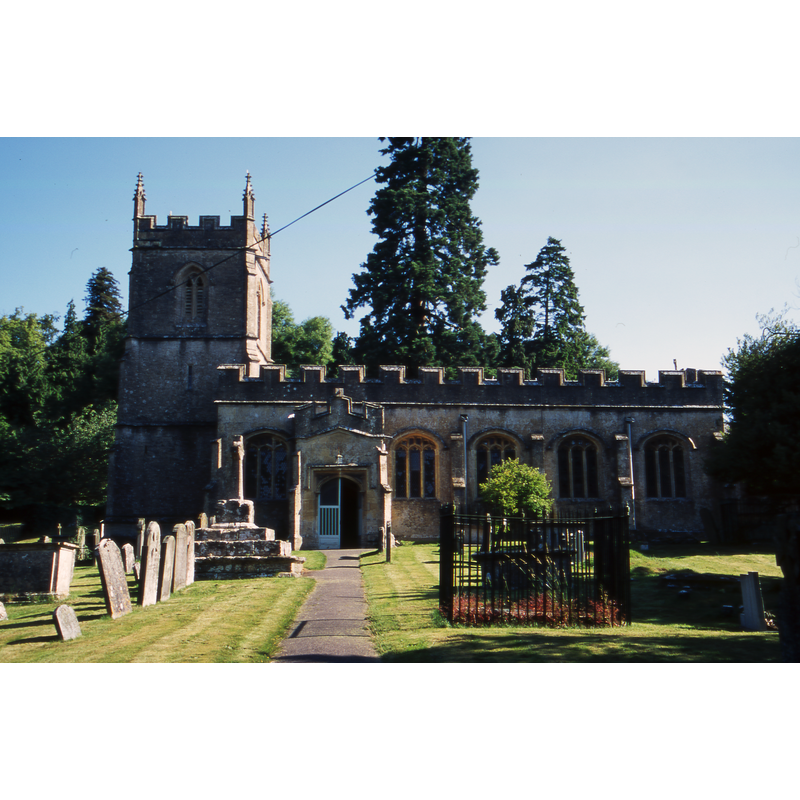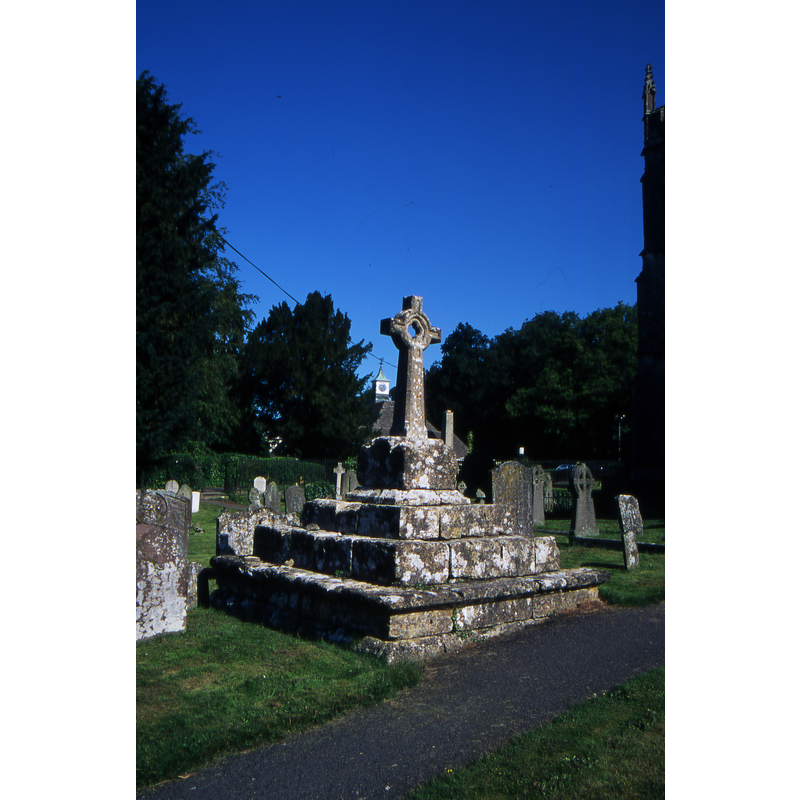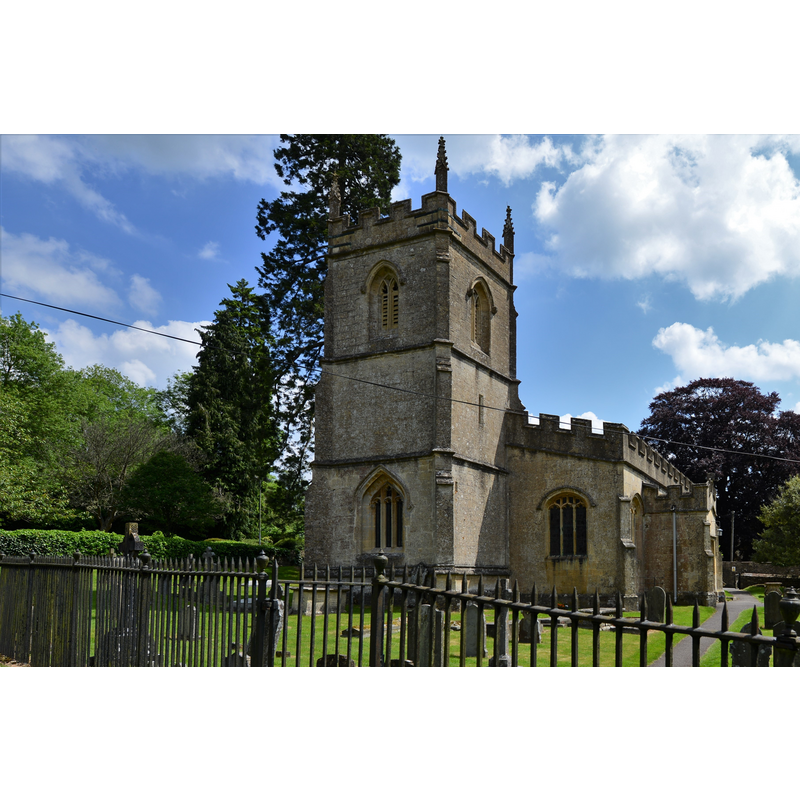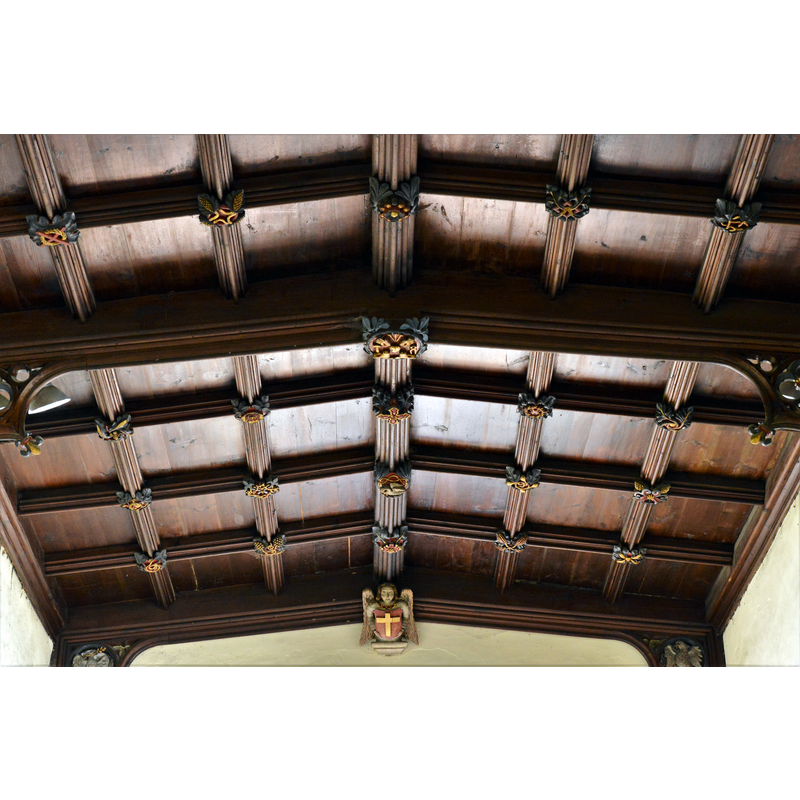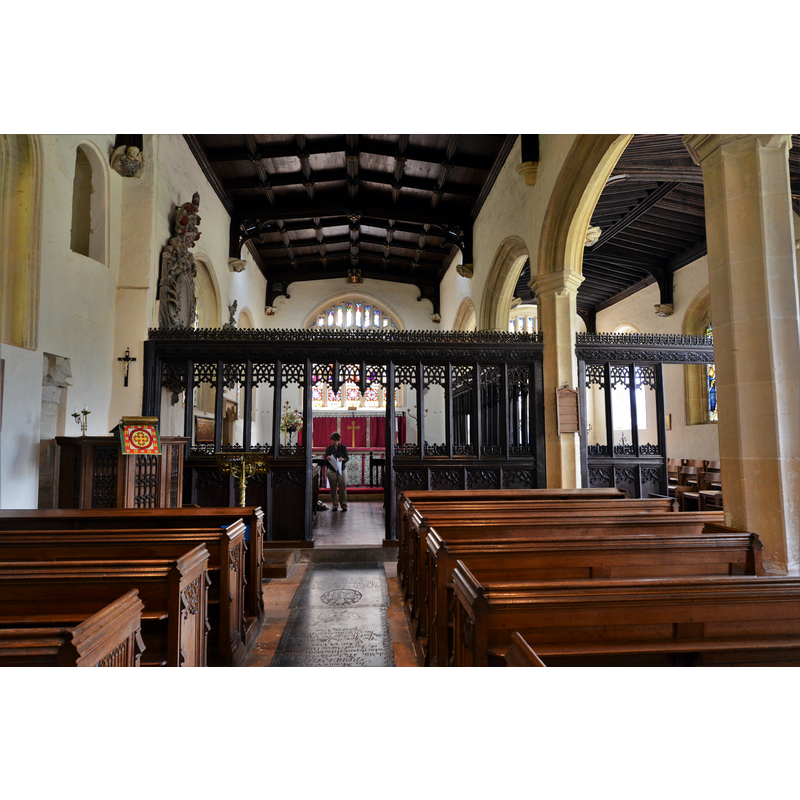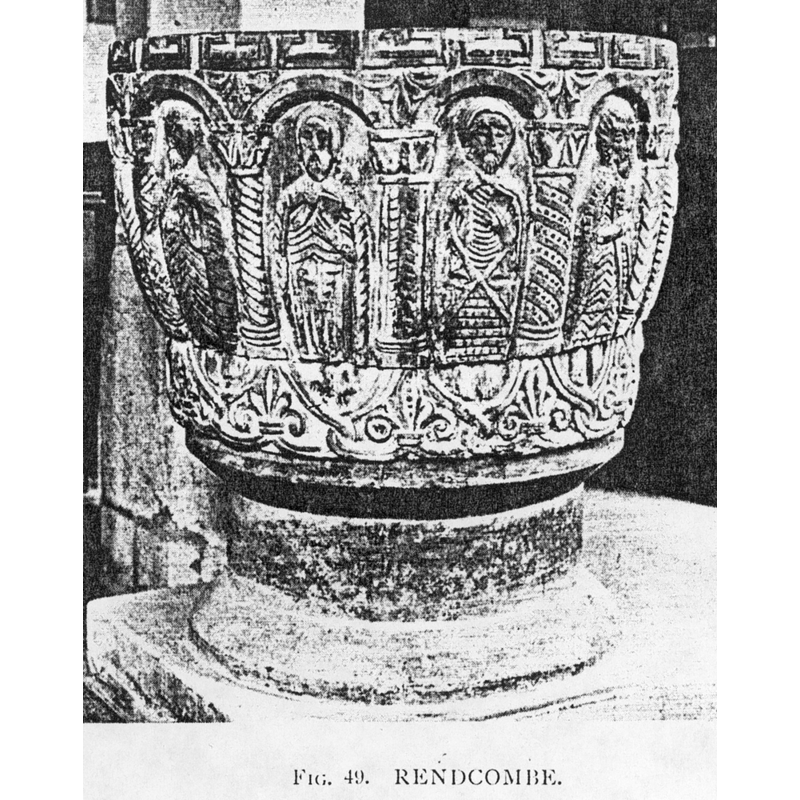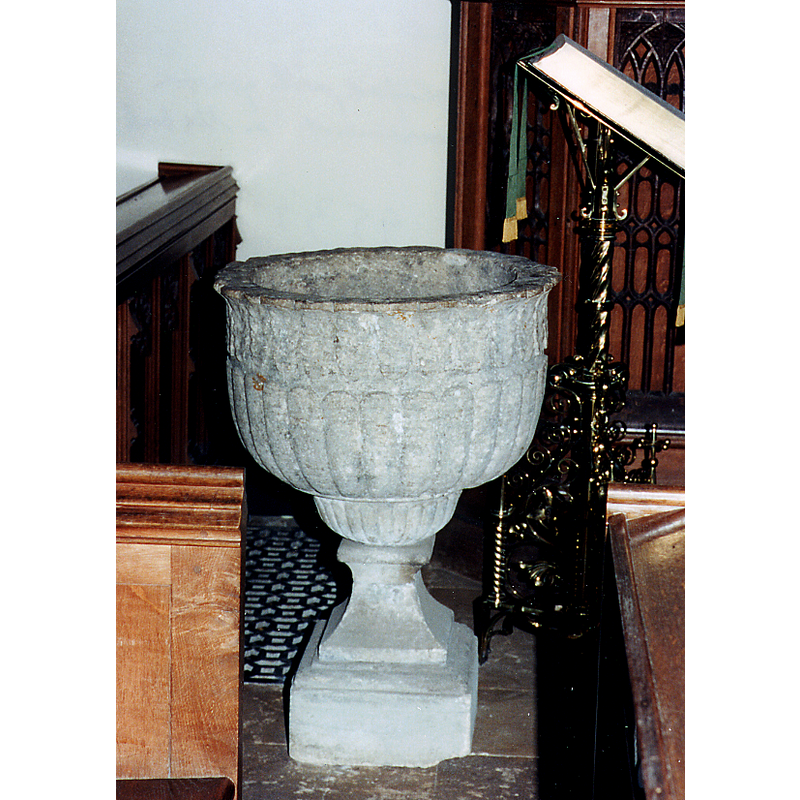Rendcomb / Rendcombe / Rindecome / Rindecumbe
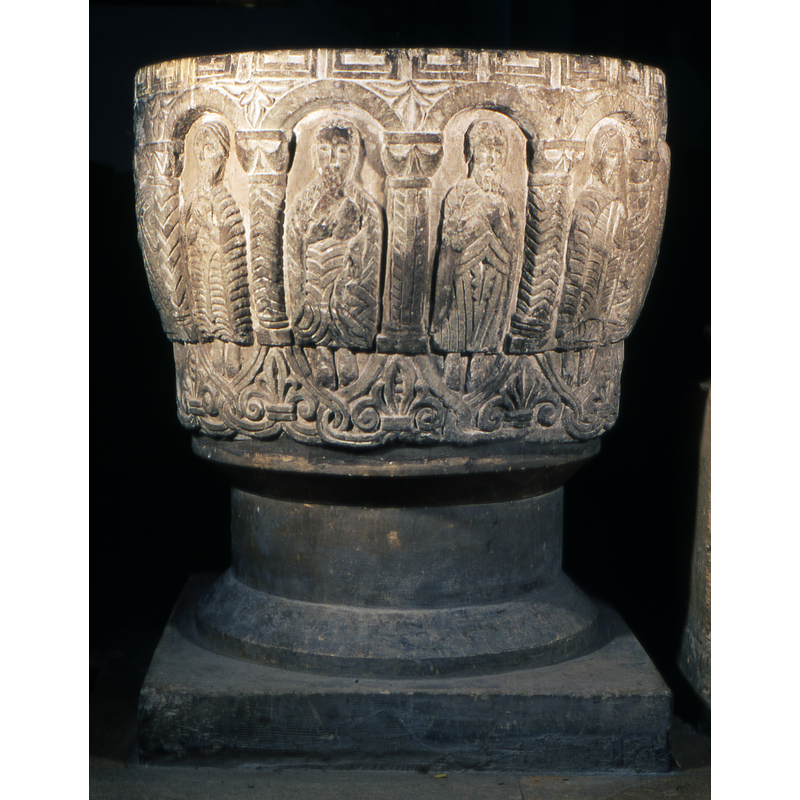
Image copyright © Baptisteria Sacra Index, 2023
Results: 19 records
Apostle or saint - Apostles - unidenitfied - 1 per niche - 12
Scene Description: the entry for this font in the CRSBI [www.crsbi.ac.uk/site/4881/] [accessed 31 January 2019] notes: "The eleven figures have been identified as eleven apostles with the disgraced twelfth, Judas, denoted by the disembodied feet under arch no. 7 (Fryer, 1910: 303; Drake, 2002: 15 and fn.). There is a projecting area of stone in the space identified with Judas as if the sculptor intended to carve a full figure, hence the carved feet below. The decision to leave the stone untouched could be symbolic, in line with the Judas identification; economically pragmatic, if the font was meant to be placed against a wall leaving this face hidden; or the product of some other enigmatic factor. It is impossible to identify each apostle independently owing to the lack of any distinctive symbols."
Copyright Statement: Image copyright © Baptisteria Sacra Index, 2023
Image Source: digital image of a photograph taken 19 July 2000 by BSI
Apostle or saint - Apostles? - unidenitfied
Scene Description: Close-up view of one of the eleven figures on the font sides. The photographer has captioned it "Rendcomb, St. Peter's Church: c12th Norman font, depicting eleven disciples with the tools of their trades" -- The entry in the CRSBI [www.crsbi.ac.uk/site/4881/] [accessed 31 January 2019] notes: "Figure 11. This figure has raised or swept back hair. His cloak is horizontally ribbed and the fabric beneath is ribbed to form upward pointing ‘V’s. Both hands are upheld, the left holding a book."
Copyright Statement: Image copyright © Michael Garlick, 2017
Image Source: digital photograph taken 10 July 2017 by Michael Garlick [www.geograph.org.uk/photo/5458997] [accessed 31 January 2019]
Copyright Instructions: CC-BY-SA-2.0
Apostle or saint - Apostles? - unidenitfied
Scene Description: Close-up view of one of the eleven figures on the font sides. The photographer has captioned it "Rendcomb, St. Peter's Church: c12th Norman font, depicting eleven disciples with the tools of their trades" -- The entry in the CRSBI [www.crsbi.ac.uk/site/4881/] [accessed 31 January 2019] notes: "Figure 4. The beard of this man is long like no. 3 and he has short hair. His eyes are almond-shaped and his nose is fairly prominent. He has a chevron enriched cloak and a ribbed tunic that forms nesting ‘V’s and circular patterns. With his left hand he clutches his cloak and in his right hand he holds an open book."
Copyright Statement: Image copyright © Michael Garlick, 2017
Image Source: digital photograph taken 10 July 2017 by Michael Garlick [www.geograph.org.uk/photo/5458996] [accessed 31 January 2019]
Copyright Instructions: CC-BY-SA-2.0
Apostle or saint - Apostles? - unidenitfied
Scene Description: Close-up view of two of the eleven figures on the font sides. The photographer has captioned it "Rendcomb, St. Peter's Church: c12th Norman font, depicting eleven disciples with the tools of their trades" -- The entry in the CRSBI [www.crsbi.ac.uk/site/4881/] [accessed 31 January 2019] notes: "Figure 11. This figure has raised or swept back hair. His cloak is horizontally ribbed and the fabric beneath is ribbed to form upward pointing ‘V’s. Both hands are upheld, the left holding a book. Figure 12. This figure is very similar to no. 6, especially in terms of the garments, but he is depicted holding a book in his left hand. His right hand appears to be gripping the clasp of his cloak."
Copyright Statement: Image copyright © Michael Garlick, 2017
Image Source: digital photograph taken 10 July 2017 by Michael Garlick [www.geograph.org.uk/photo/5458980] [accessed 31 January 2019]
Copyright Instructions: CC-BY-SA-2.0
Apostle or saint - Apostles? - unidenitfied
Scene Description: Close-up view of two of the eleven figures on the font sides. The photographer has captioned it "Rendcomb, St. Peter's Church: c12th Norman font, depicting eleven disciples with the tools of their trades" -- The entry in the CRSBI [www.crsbi.ac.uk/site/4881/] [accessed 31 January 2019] notes: "Figure 9. This figure is also obscured by the adjacent pier. He has a beard, swept-back hair and elliptical eyes. His robes are decorated with chevron and a central vertical strap. In his right hand he holds an object akin to a sceptre and in his left he holds a book."
Copyright Statement: Image copyright © Michael Garlick, 2017
Image Source: digital photograph taken 10 July 2017 by Michael Garlick [www.geograph.org.uk/photo/5458977] [accessed 31 January 2019]
Copyright Instructions: CC-BY-SA-2.0
blank
Scene Description: the entry for this font in the CRSBI [www.crsbi.ac.uk/site/4881/] [accessed 31 January 2019] notes: "The eleven figures have been identified as eleven apostles with the disgraced twelfth, Judas, denoted by the disembodied feet under arch no. 7 (Fryer, 1910: 303; Drake, 2002: 15 and fn.). There is a projecting area of stone in the space identified with Judas as if the sculptor intended to carve a full figure, hence the carved feet below. The decision to leave the stone untouched could be symbolic, in line with the Judas identification; economically pragmatic, if the font was meant to be placed against a wall leaving this face hidden; or the product of some other enigmatic factor. It is impossible to identify each apostle independently owing to the lack of any distinctive symbols."
Copyright Statement: Image copyright © Baptisteria Sacra Index, 2023
Image Source: digital image of a photograph taken 19 July 2000 by BSI
design element - architectural - arcade - round arches - columns with capitals and bases - patterned columns
Scene Description: commented thus in the CRSBI [www.crsbi.ac.uk/site/4881/] [accessed 31 January 2019]: "The stylised piers of the font are incised with various geometric decoration. A similar practice can be seen on full-scale examples at several regional churches, including Windrush, Wotton (Gloucestershire) and Begbroke (Oxfordshire). These manors were all held by Miles and/or Roger (Turnock, 2014: 58-9). This type of architectural decoration can be traced to Lanfranc’s cathedral at Canterbury and subsequently spread across the Britain, with renowned late 11th to early 12thc examples at Durham Cathedral. The stylised recessed scallop capitals on the Rendcomb font can be compared to full-size examples on the reset chancel arch at English Bicknor, another church that has been attributed to Miles (Turnock, 2014: 61-4; idem, CRSBI)."
Copyright Statement: Image copyright © Baptisteria Sacra Index, 2023
Image Source: digital image of a photograph taken 19 July 2000 by BSI
design element - motifs - floral - fleur-de-lis
design element - motifs - foliage
design element - motifs - fret
view of church exterior
view of church exterior - churchyard, cemetery - cross
view of church exterior - west view
view of church interior - chancel - ceiling - detail
view of church interior - looking east
view of font
view of font
view of font in context
INFORMATION
FontID: 02503REN
Object Type: Baptismal Font1
Church/Chapel: Parish Church of St. Peter [originally from Elmore Court chapel [cf. FontNotes]]
Church Patron Saints: St. Peter
Church Location: The Dr, Rendcomb, Cirencester GL7 7HF, UK
Country Name: England
Location: Gloucestershire, South West
Directions to Site: From Cirencester take the A435 north (dir. Cheltenham) for 5-7 km; continue pass North Cerney for 1 km or so, and the next right turn leads to Rendcomb.
Ecclesiastic Region: Diocese of Gloucester
Historical Region: Hundred of Rapsgate
Font Location in Church: Inside the church
Century and Period: 12th century [basin only], Medieval [composite]
Workshop/Group/Artisan: Herefordshire school
Cognate Fonts: Newnham-on-Severn and Mitcheldean fonts in Gloucs. and the font at Hereford cathedral. Also probably related is the font base at Burghill. [cf. FontNotes]
Credit and Acknowledgements: We are grateful to John Wilkes, of www.allthecotswolds.com, for his help in documenting this font
Church Notes: The large cross in the church yard has a base which looks suspiciously like an upside-down font basin.
Font Notes:
Click to view
There are two entries for Rendcomb [variant spelling] in the Domesday survey [https://opendomesday.org/place/SP0109/rendcomb/] [accessed 30 January 2019] neither of which mentions cleric or church in it. Tymms (1834) ists a font here. Described and illustrated in Tyrrell-Green (1928) as one of "the group of three fonts, evidently produced by the same hand, or by the same school of workmen, at Hereford Cathedral, Micheldean (Glos), and Rendcombe (Glos)[...] In these cases the figures are intended to represent the Apostles, each being distinguished by his emblem." Buck (1951) notes that "the Twelve Apostles" is a "subject is carved on over twenty other fonts in various parts of the country" and mentions those at Avington (Berkshire), Gloucester Cathedral, Micheldean and Rendcomb (Gloucestershire) and Chirton (Wiltshire) as examples of the group. Stone (1955) comments on the style of decoration: "The style of this group is further evidence of a mid-century geometrical return to barbaric tastes; pillars and arches are elaborately adorned with beading, chevron, spirals, and other patterns, while the draperies of the apostles have been reduced to flat linear patterns of lozenge, chevron, and parallel incisions on oblong blocks from which protrude feet and head, the whole being reminiscent of the aesthetic concepts that lay behind the apostle figures of the Book of Kells, four centuries before." The entry for this parish in the Victoria County History (Gloucester, vol. 7, 1981) notes: "The earliest record found of the church at Rendcomb was in 1255 [...] From the early church three piers of a 13th-century arcade, incorporated in the north wall, are all that survive. Otherwise the whole building is the product of a rebuilding carried out in the early 16th century [...] The Norman font, decorated with figures of the apostles,[...] came from the old chapel at Elmore Court and was used as a garden ornament at Rendcomb Park before being installed in the church in the mid 19th century. [...] It replaced a plainer tub-shaped font, also apparently Norman work." Noted in Verey & Brooks (1999-2002) as similar to that at Hereford Cathedral and "said to have been brought by the Guise family from the capel at Elmore Court […] and used as garden ornament in Rendcomb Park until the mid C19. It is a superb work of art"; this source futher notes a later, "C18, chalice-shaped" font in this church. The entry for this church in the CRSBI (2019) notes: "The church holds only one Romanesque artefact, a sculpted stone font. This was originally located within the old chapel at Elmore Court, located a few miles south-west of Gloucester. There is still a small chapel at Elmore Court but this is of a later construction. The font was used as a garden ornament in Rendcomb Park before being brought inside St Peter’s church in the mid-19thc (Herbert, 1981: 227). [...] The history of Rendcomb manor is irrelevant in terms of understanding the history of the font as it did not originally belong to the parish church. On the basis of the available evidence, it must be assumed that the font was made for the chapel at Elmore Court, although the possibility that it was moved to Elmore from elsewhere cannot be ruled out. [...] Elmore chapel is first recorded in a confirmation charter of Simon bishop of Worcester issued between 1144 and 1148. From this, it can be inferred that the chapel was part of the endowment of Llanthony Secunda Priory, Gloucester, which was founded in 1137 by Miles. [...] A cylindrical stone font with a slight taper (bombés) set on a modern plinth, located within the nave. It is carved with eleven standing male figures, each beneath a stylised arch. [...] The eleven figures have been identified as eleven apostles with the disgraced twelfth, Judas, denoted by the disembodied feet under arch no. 7 (Fryer, 1910: 303; Drake, 2002: 15 and fn.). There is a projecting area of stone in the space identified with Judas as if the sculptor intended to carve a full figure, hence the carved feet below. The decision to leave the stone untouched could be symbolic, in line with the Judas identification; economically pragmatic, if the font was meant to be placed against a wall leaving this face hidden; or the product of some other enigmatic factor. It is impossible to identify each apostle independently owing to the lack of any distinctive symbols. The richly decorated arches and foliage may represent the Kingdom of Heaven or New Jerusalem (Revelation, 3:12 and 21:2–21). [...] The Rendcomb font is part of a group of four closely-related fonts that were evidently carved by the same sculptor or workshop (Gethyn-Jones, 1979: 39; Drake, 2002: 15; Baxter). The others can be found at Hereford Cathedral, Mitcheldean and Newnham-on-Severn (Gloucestershire) [...] Gethyn-Jones (1979: 40) accepted a date of c. 1140-45 for the Hereford and Newnham fonts, and presumably situated the Rendcomb font within a similar time bracket. This accords with the documentary evidence. Elmore chapel seems to have been constructed around the time that it was granted to Llanthony Secunda c. 1137. The chapel was not necessarily completed by 1137 since grants sometimes anticipated rebuilding campaigns. Although the chapel belonged to the Augustinian canons of Llanthony Secunda after this date, Miles and Roger presumably retained an interest in the foundation and could have funded subsequent commissions. The presence of closely related fonts at other earldom of Hereford manors seems to confirm that Miles and/or Roger were responsible for the Rendcomb font. They do emerge as major patrons of ecclesiastical architecture and sculpture in this period, and the quality of the font is consistent with it being created under the patronage of an eminent secular lord (Turnock, 2014: 48-93)." On-site notes: a font from the Hereford group, cognate of the ones at Newnham-on-Severn, Mitcheldean and Hereford cathedral. Goblet-shaped with twelve niches around the basin containing eleven figures that coul be the Apostles and one blank niche (Judas?) [NB: thanks are owed to John Wilkes for pointing out that the blank niche, supposed to be Judas Iscariot's, faces north]. Anglo-Norman motifs adorn the arches themselves and the upper and lower rims of the basin; the plain cylindrical base and square plinth are of a later date; the inside of the basin well appears to have been re-sealed and does not show the original depth or carving marks [cf. the cognate font at Newham-on-Severn for an idea of its original shape and depth]. [NB: Jenkins (1999) reports "another font is by the pulpit, filled with flowers on my visit." This is a large chalice-shaped font ornamented with foliage and ribbed or gadron patterns; probably 18th-century [not indexed on account of its late date]].
COORDINATES
Church Latitude & Longitude Decimal: 51.78708, -1.9749
Church Latitude & Longitude DMS: 51° 47′ 13.49″ N, 1° 58′ 29.64″ W
UTM: 30U 570706 5737854
MEDIUM AND MEASUREMENTS
Material: stone, limestone
Number of Pieces: three
Font Shape: tub-shaped
Basin Interior Shape: round
Basin Exterior Shape: round
Drainage Notes: *The basin well, which does not have the original depth, is unlined and appears to have been re-sealed
Rim Thickness: 14 cm
Diameter (inside rim): 62 cm
Diameter (includes rim): 88-90 cm
Basin Depth: 25 cm*
Basin Total Height: 60 cm
Height of Base: 33 cm
Font Height (less Plinth): 93 cm
Font Height (with Plinth): 105 cm
Notes on Measurements: BSI. *[NB: cf. FonNotes regarding the inside of the basin well and its depth]
REFERENCES
Victoria County History [online], University of London, 1993-. Accessed: 2019-01-30 00:00:00. URL: https://www.british-history.ac.uk.
Betjeman, John, An American's Guide to English Parish Churches (including the Isle of Man), New York: McDowell, Obolensky, 1958
Buck, A.G. Randle, "Some Wiltshire fonts. Part II", LIV, CXCIV (June 1951), The Wiltshire Archaeological and Natural History Magazine, 1951, pp. 19-35; p. 26
Corpus of Romanesque Sculpture in Britain and Ireland, The Corpus of Romanesque Sculpture in Britain and Ireland, The Corpus of Romanesque Sculpture in Britain and Ireland. Accessed: 2019-01-30 00:00:00. URL: http://www.crsbi.ac.uk.
Gethyn-Jones, Eric, The Dymock School of Sculpture, London: Phillimore, 1979
Jenkins, Simon, England's Thousand Best Churches, London and New York: Allen Lane, the Penguin Press, 1999 [2000 rev. printing]
Pevsner, Nikolaus, Nottinghamshire, Harmondsworth: Penguin Books, 1979
Stone, Lawrence, Sculpture in Britain: the Middle Ages, Harmondsworth: Penguin Books, 1955
Tymms, Samuel, Family Topographer, being a compendious account of the antient and present state of the counties of England: vol. IV, Oxford circuit, London: Nichols & Son, 1834
Tyrrell-Green, E., Baptismal Fonts Classified and Illustrated, London: Society for Promoting Christian Knowledge: The Macmillan Co., 1928
Verey, David, Gloucestershire, London: Penguin Books, 1999-2002
![the entry for this font in the CRSBI [www.crsbi.ac.uk/site/4881/] [accessed 31 January 2019] notes: "The eleven figures have been identified as eleven apostles with the disgraced twelfth, Judas, denoted by the disembodied feet under arch no. 7 (Fryer, 1910: 303; Drake, 2002: 15 and fn.). There is a projecting area of stone in the space identified with Judas as if the sculptor intended to carve a full figure, hence the carved feet below. The decision to leave the stone untouched could be symbolic, in line with the Judas identification; economically pragmatic, if the font was meant to be placed against a wall leaving this face hidden; or the product of some other enigmatic factor. It is impossible to identify each apostle independently owing to the lack of any distinctive symbols."](/static-50478a99ec6f36a15d6234548c59f63da52304e5/compressed/REN0004903_compressed.png)
![Close-up view of one of the eleven figures on the font sides. The photographer has captioned it "Rendcomb, St. Peter's Church: c12th Norman font, depicting eleven disciples with the tools of their trades" -- The entry in the CRSBI [www.crsbi.ac.uk/site/4881/] [accessed 31 January 2019] notes: "Figure 11. This figure has raised or swept back hair. His cloak is horizontally ribbed and the fabric beneath is ribbed to form upward pointing ‘V’s. Both hands are upheld, the left holding a book."](/static-50478a99ec6f36a15d6234548c59f63da52304e5/compressed/1190131001_compressed.png)
![Close-up view of one of the eleven figures on the font sides. The photographer has captioned it "Rendcomb, St. Peter's Church: c12th Norman font, depicting eleven disciples with the tools of their trades" -- The entry in the CRSBI [www.crsbi.ac.uk/site/4881/] [accessed 31 January 2019] notes: "Figure 4. The beard of this man is long like no. 3 and he has short hair. His eyes are almond-shaped and his nose is fairly prominent. He has a chevron enriched cloak and a ribbed tunic that forms nesting ‘V’s and circular patterns. With his left hand he clutches his cloak and in his right hand he holds an open book."](/static-50478a99ec6f36a15d6234548c59f63da52304e5/compressed/1190131002_compressed.png)
![Close-up view of two of the eleven figures on the font sides. The photographer has captioned it "Rendcomb, St. Peter's Church: c12th Norman font, depicting eleven disciples with the tools of their trades" -- The entry in the CRSBI [www.crsbi.ac.uk/site/4881/] [accessed 31 January 2019] notes: "Figure 11. This figure has raised or swept back hair. His cloak is horizontally ribbed and the fabric beneath is ribbed to form upward pointing ‘V’s. Both hands are upheld, the left holding a book. Figure 12. This figure is very similar to no. 6, especially in terms of the garments, but he is depicted holding a book in his left hand. His right hand appears to be gripping the clasp of his cloak."](/static-50478a99ec6f36a15d6234548c59f63da52304e5/compressed/1190131003_compressed.png)
![Close-up view of two of the eleven figures on the font sides. The photographer has captioned it "Rendcomb, St. Peter's Church: c12th Norman font, depicting eleven disciples with the tools of their trades" -- The entry in the CRSBI [www.crsbi.ac.uk/site/4881/] [accessed 31 January 2019] notes: "Figure 9. This figure is also obscured by the adjacent pier. He has a beard, swept-back hair and elliptical eyes. His robes are decorated with chevron and a central vertical strap. In his right hand he holds an object akin to a sceptre and in his left he holds a book."](/static-50478a99ec6f36a15d6234548c59f63da52304e5/compressed/1190131004_compressed.png)
![the entry for this font in the CRSBI [www.crsbi.ac.uk/site/4881/] [accessed 31 January 2019] notes: "The eleven figures have been identified as eleven apostles with the disgraced twelfth, Judas, denoted by the disembodied feet under arch no. 7 (Fryer, 1910: 303; Drake, 2002: 15 and fn.). There is a projecting area of stone in the space identified with Judas as if the sculptor intended to carve a full figure, hence the carved feet below. The decision to leave the stone untouched could be symbolic, in line with the Judas identification; economically pragmatic, if the font was meant to be placed against a wall leaving this face hidden; or the product of some other enigmatic factor. It is impossible to identify each apostle independently owing to the lack of any distinctive symbols."](/static-50478a99ec6f36a15d6234548c59f63da52304e5/compressed/REN0004512_compressed.png)
